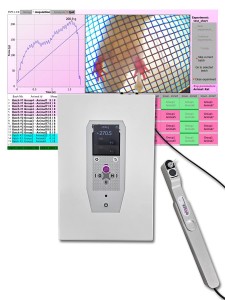Authors
IA Dyachenko, YA Palikova, VA Palikov et al
Lab
Russian Academy of Sciences, Moscow, Russia
Journal
Biochimie
Abstract
_ligoarginines were recently discovered (Lebedev et al., 2019 Nov) as a novel class of nicotinic acetylcholine receptors (nAChRs) inhibitors, octaoligoarginine R8 showing a relatively high affinity (44 nM) for the alpha9/alpha10 nAChR. Since the inhibition of alpha9/ alpha 10 nAChR by alpha-conotoxin RgIA and its analogs is a possible way to drugs against neuropathic pain, here in a mice model we compared R8 with alpha-conotoxin RgIA in the effects on the chemotherapy-induced peripheral neuropathy (CIPN), namely on the long-term oxaliplatin induced neuropathy. Tests of cold allodynia, hot plate, Von Frey and grip strength analysis revealed for R8 and alpha-conotoxin RgIA similar positive effects, expressed most prominently after two weeks of administration. Histological analysis of the dorsal root ganglia sections showed for R8 and RgIA a similar partial correction of changes in the nuclear morphology of neurons. Since alpha9/ alpha 10 nAChR might be not the only drug target for R8, we analyzed the R8 action on rat TRPV1 and TRPA1, well-known nociceptive receptors. Against rTRPV1 at 25 microM there was no inhibition, while for rTRPA1 IC50 was about 20 microM. Thus, involvement of rTRPA1 cannot be excluded, but in view of the R8 much higher affinity for alpha 9/ alpha 10 nAChR the latter seems to be the main target and the easily synthesized R8 can be considered as a potential candidate for a drug design.
BIOSEB Instruments Used
Electronic Von Frey 5 with embedded camera (BIO-EVF5),Electronic Von Frey 4 (BIO-EVF4)
Source :

 Pain - Thermal Allodynia / Hyperalgesia
Pain - Thermal Allodynia / Hyperalgesia Pain - Spontaneous Pain - Postural Deficit
Pain - Spontaneous Pain - Postural Deficit Pain - Mechanical Allodynia / Hyperalgesia
Pain - Mechanical Allodynia / Hyperalgesia Learning/Memory - Attention - Addiction
Learning/Memory - Attention - Addiction Physiology & Respiratory Research
Physiology & Respiratory Research











![Dynamic Weight Bearing 2.0 – Postural Module [Add-on]](https://bioseb.com/733-home_default/dynamic-weight-bearing-20-add-on-postural-module.jpg)
























 Pain
Pain Central Nervous System (CNS)
Central Nervous System (CNS) Neurodegeneration
Neurodegeneration Sensory system
Sensory system Motor control
Motor control Mood Disorders
Mood Disorders Other disorders
Other disorders Muscular system
Muscular system Joints
Joints Metabolism
Metabolism Cross-disciplinary subjects
Cross-disciplinary subjects CONFERENCES & MEETINGS
CONFERENCES & MEETINGS 
